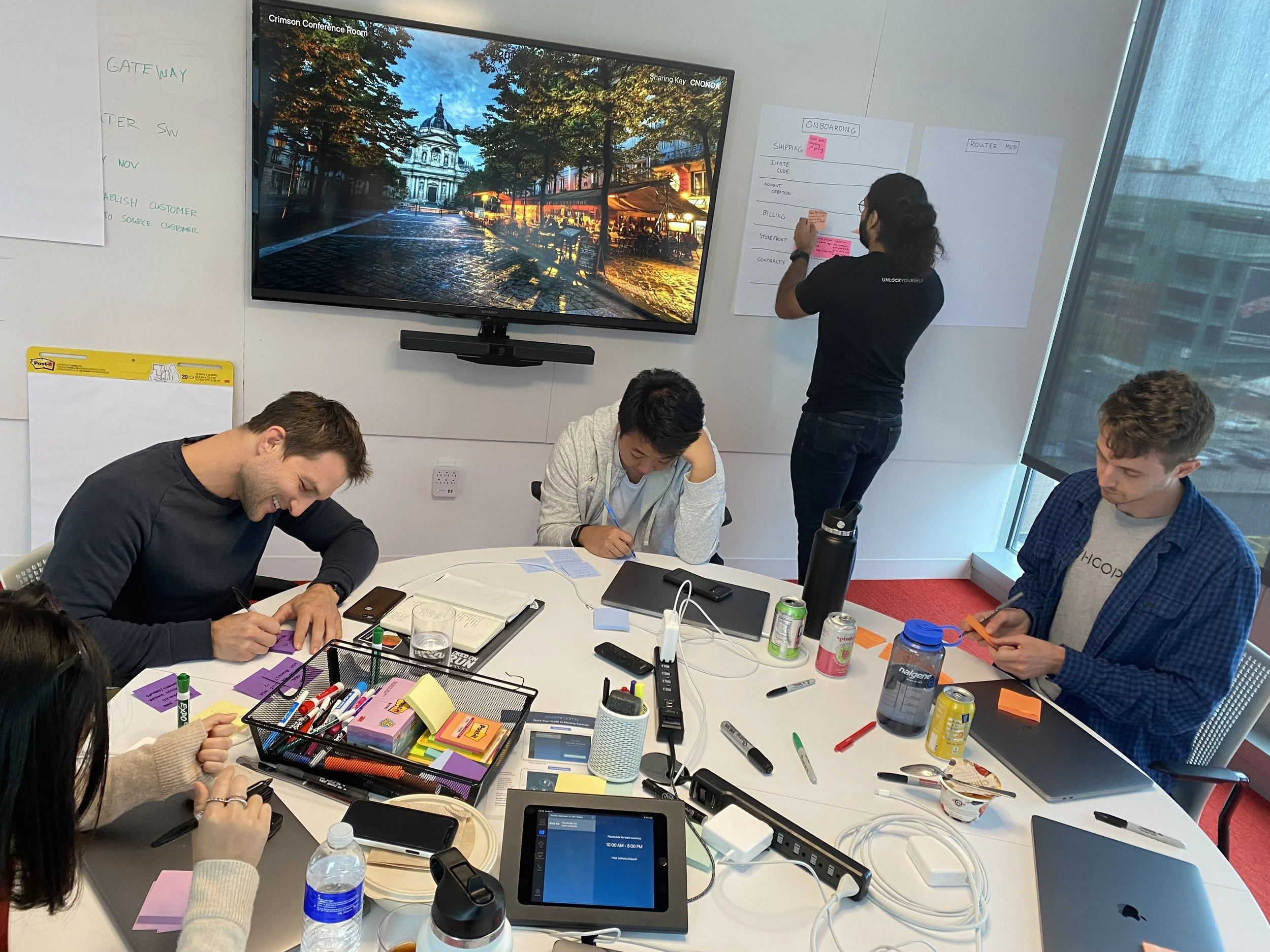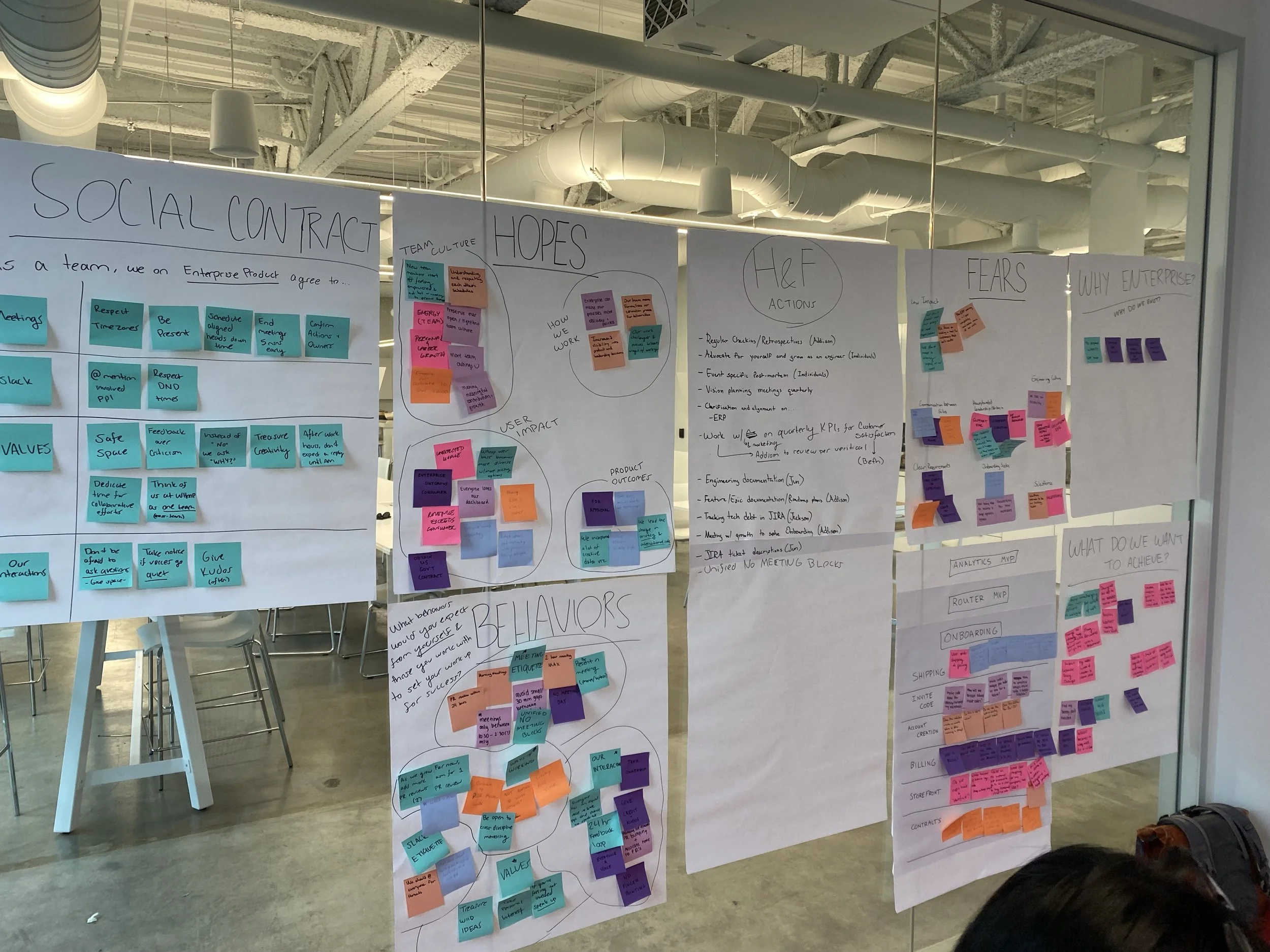Unlocking Group Performance with WHOOP Unite
Scaling the power of WHOOP to reveal how individual behavior impacts a greater whole through B2B growth and team analytics.
Role
Lead Product Designer
Timeline
April 2021—Sept 2022
Company
WHOOP
Domain
B2B Fitness & Wellness

Disclaimer: This is a designer’s case study, authored & published individually. All information in this case study is my own and does not necessarily reflect the views of WHOOP. I have obfuscated confidential information and locked this page after the company discontinued public publications of WHOOP Unite.
“If we do this right, we could save people’s lives by wearing WHOOP.”
– Robert Moeller, Assoc. VP of WHOOP for Government
Spoiler Alert: We didn’t do it right. But we radically changed our flagship product based on what we learned.
〰️
Spoiler Alert: We didn’t do it right. But we radically changed our flagship product based on what we learned. 〰️
“How do you feel about working with the military?”
When I was first interviewing for the job with WHOOP, this was one of the last questions I was posed by the VP of Engineering. My interest in this team was undeterred, but I was curious. Why did the military specifically come up as if it would sway me, when we had already been reviewing use cases that required complex privacy needs?
When I started with the team, I got my answer.
An ex-Navy Seal circled the room, applying his very best sales skills as he aimed to convince a dozen of us to prioritize risk mitigation use cases in the software development roadmap. He leaned in ominously, making eye contact with every one of us as he circled like a lion. Engineers fresh out of college shifted in their seats while others puffed up their chests at the challenge to hold his gaze.
This was Robert Mueller, the Director of Military Teams and a sales guru who led much of the way in the early years of the B2B segment at WHOOP. We held our breaths as he told us a story about the last funeral he attended—it was his friend, who died tragically after falling out of a helicopter in training.
How did he die? Sleep deprivation.
How could WHOOP help? Alerting his commanding officer when his people are pushing their bodies in under recovered states. So when he tells us that using this wearable could save people’s lives, he’s speaking quite literally. I was asked about my willingness to work on projects like this because this team’s intensity had driven out the original enterprise designer before me, who had quit two months into the job. This intensity set the stage for a high passion team who wanted to change the world.
The potential was energizing. The people who wore WHOOP loved WHOOP—to sometimes a die-hard degree. Yet for a non-Crossfitting, “ordinary” person, they just didn’t care about quantifying and optimizing their movement. When they weren’t buying, it become obvious that the crew was missing something. So the team adjusted their gaze towards the B2B space as a profit engine to learn and break into the “less motivated” markets.
About WHOOP
WHOOP is a 24/7 wearable & mobile app on a mission to unlock human performance. When I joined the team, this late stage startup was taking the consumer fitness world by storm with comprehensive tracking to help people perform through a deeper understanding of their bodies.
My Role
I was hired to craft the future of WHOOP for teams.
Our team was small but mighty—starting as four (myself and three engineers) before eventually growing to a software team of twelve.
I individually led the design and research for this product for the first year and a half before I hired Weinan Li, a senior product designer, to continue to evolve the offering to what it is today as my scope grew in the company.
🤭 My management journey is a separate story to tell.
Introducing WHOOP Unite
WHOOP Unite puts more control in the coaches’ hands. The platform was built to support scale across large organizations leveraging WHOOP 4.0.
Team analytics dashboards that empower coaches and leaders to make decisions to optimize team performance.
Individual analytics to allow informed coaching and relationship management.
Onboarding education empowers administrators to take action at scale by being easily introduced to the science of WHOOP.
Administrative tools to manage enterprise seats for customer success.
Configuration controls to manage privacy and hierarchical settings.
As an enterprise tool, meaningful outcomes looked less like logging in everyday and more focused on big wins when you are working towards a goal. Our KPIs focused on behavior change tracking that were connected with the goals the customer* brought to us at the time of forming a B2B partnership.
*More on who we were serving in The Approach .
Notable Wins
At the end of 2023...
46%
fewer days of alcohol consumption across all B2B customers.
27%
increase in days meditated across Workplace Wellness customers.
59%
improvement in fitness levels for athletic customers.
52%
increase in quality of sleep averaged across all B2B customers.
The business needed to spend less money supporting enterprise partnerships.
Tailoring exclusive team experiences was not new for the company, but it was inefficiently handled customer-to-customer using Salesforce, pivot tables, and a legacy web tool that was built in 2017 to land one customer, and had not been touched since! Based on the current workflows, the team had a defined idea of what they needed their MVP experience to be:
Streamline the account management workflow to make it easier for a B2B client to purchase WHOOP as a group.
Starting as a growth platform with self-service configurations to tailor a range of privacy and distribution needs, this could pave the way for more comprehensive analytics later.
When asking, “who are we serving?” to over a dozen stakeholders in my first week, I received a breadth of different answers. The first thing I noticed was a discrepancy in what internal voices were expecting out of this new product:
External dashboard
Software and product executives—the ones who hired us—were expecting a high quality, marketable and user-facing offering that could advance WHOOP’s portfolio. They wanted this to embody the “cool factor” that the flagship mobile app was gaining popular traction for, with an extension of data visualization and coaches’ tools.
Internal administration
The business teams in sales, customer success, and support—the ones currently doing the work—were expecting to be the target users of this new tool, making it an internal efficiency tool that made it possible for them to support more customers. Sure, dashboards would be cool, but it wasn’t the top need.
In my stakeholder interviews, I found myself exercising “the new guy” privilege in order to gain more context on where the most influential reservations were.
I unearthed a deep rooted fear that if we were successful at building a self-service B2B growth platform, we would be designing our customer success and sales teams out of jobs.
Learning this helped me form a new game plan around how we might empower our internal teams to do their best work by focusing on automating the most mundane administrative tasks, so that they could focus on building meaningful, human connections.
Kickoff workshops revealed that “compliance” was low—companies were gifting WHOOPs to their people, but people weren’t using it. When people were given WHOOP straps “for free” as a part of their subsidized enterprise plans, they had to navigate a complex application without feeling convinced this product was for them. Considering when you see marketing campaigns about WHOOP, you see a whole lot of sweaty abs, the hurdle to our growth became clear—most B2B end users were not identifying with what was presented as our target audience.
WHOOP didn’t seem like a product to help you meet your goals, it seemed like a product that was used by people who were already maintaining amazing and disciplined lifestyles.
That, and many people saw the monthly payment as incentive to get their money’s worth—How might we experiment with new incentives to match goals to motivations when people don’t need to pay to use WHOOP?
From here, I introduced the software and business teams to design thinking methodologies, facilitating kickoff & alignment workshops to understand current ways of working and foster more candid communication across the teams. Many processes weren’t written down yet, so I mapped out “today’s” task flows and invited big thinking to envision tomorrow’s experience. Teams that initially dug in their heels started to open up and feel listened to.
As a remote, distributed team, we would travel into Boston for more intensive workshops, such as designing how we work together with social contracts and following research to design our site map, while for ad hoc needs we would jump on a call with a Figjam.
Data Constraint: We did not have trustworthy data on how B2B programs were performing.
When baselining renewal rates, customer satisfaction, and success metrics, I learned that we didn’t yet have structure around how we spoke to success. We ran deal failure audits and retrospectives, but for the first quarter I received rough estimates in stakeholder interviews, because the team wasn’t tracking KPIs yet.
of B2B customers would not scale up from their initial pilot.
of B2B customers would not renew for a second term.
I began shadowing Customer Success team members as they took hours to generate a monthly insights report, were influenced by customer budgets, chased down renewal deadlines and tried to convince groups of enterprise plan members to wear their WHOOPs.
Quantifying baselines through perceived time spent on tasks & rooting out the least enjoyable tasks.
Analyzing lost deals with Sales.
*Intentionally blurred
Who we were serving
Almost all of our B2B customers could be categorized by 4 business verticals:
Athletic teams needed insight into how their athletes were performing, and whether they were ready for game day.
Public service teams needed to protect the safety of their first responders for risk mitigation.
Workplaces needed to understand the toll that stress was taking on their workforce to reduce employee burnout.
Healthcare clients needed passive data collection to advance life sciences and research—they cared less for mobile UX and more about the data that came from wearing WHOOP through clinical studies.
There was a lot of hope to find common ground in serving all of these verticals, but through discussion and speculation we prioritized athletic teams based on product / market fit with our current mobile capabilities. We placed the other verticals into “investigative” states, where we still supported them but prioritized granting to greatest benefits first to athletics when we observed and learned about the others.
Defining user roles.
The Buyer “Account Owner”
Needs to clearly understand the ROI on their plan, sometimes functioning in a specialized environment with a clear connection to organizational goals.
Admin “Workspace Manager”
Needs to easily administer programs to groups of people, navigating information often without being a WHOOP user themselves.
Cohort Lead “Collaborator”
Needs access to a range of data granularities with actionable insights to improve health outcomes based on patterns.
Seat holder “WHOOP Member”
Needs to feel excited about what they learn by using WHOOP, with high trust and control over their data privacy.
Our MVP didn’t need to reinvent the wheel—our analytics platform could do that.
We now had a slew of pain points, and alignment on a backlog of worthy opportunities to pursue. We then hit another constraint—our business teams did not want us speaking directly to customers out of concern that we may reveal how early we were in product development, causing them to abandon renewals.
This wasn’t favorable, yet looking at our MVP feature list, we weren’t prioritizing moon shots that the market hadn’t yet seen—we just wanted to make it easier to purchase and assign enterprise seats. So we compromised and focused on making our MVP launch internal, with our users being WHOOP employees.
Exercises to accelerate MVP planning & site maps to organize our information architecture.
Sketches & wireframing to gain buy in on ideas, inexpensively.
Usability testing revealed that we were ready to start onboarding clients, although there was desire to build more robust features before we started marketing externally.
After internal usability testing & refinements, we launched the MVP in September 2021, five months after starting. After addressing fast follows, we started weekly checkpoints and monthly product showcases across the company as we continue to hone our account management functionality.
Moving external with analytics discovery research.
We now enter the new era of WHOOP Unite: introducing analytics.
When we talk about analytics though, we aren’t just talking about exposing data in a sexy way (though we had some interesting internal conversations about that). We’re talking taking the science of WHOOP across Sleep, Recovery, Strain, Stress, and Health Monitors and making it possible to derive insights when taking multiple unique people into consideration. We learned from shadowing customer calls with Customer Success and Sales that it was currently incredibly hard to draw patterns across multiple customers.
At this point, we had no dedicated user researcher on the team. I pitched (and won) support to hire a temporary UXR contractor to help us make sense of the wide range of use cases to inform our analytics roadmap for 2022.
Together, her and I recruited a cohort of over a dozen people from 8 customer accounts across the business verticals. Over 8 weeks, we spent up to 5 hours individually with each participant and published a 100+ page report of insights.
We partnered with a range of roles—from sports scientists and strength & conditioning coaches in the professional sports realm, to hospital owners in the UK, to HR administrators in corporations. We worked deeper with our military sales team as representatives of government & defense clients. We gathered stories through discovery interviews, jobs to be done exercises, and for some even began whiteboard futures to speculate what could radically change with the evidence-based decision making that WHOOP Unite could grant them.
“The number one killer for [forest firefighters] isn’t the damn fires… it’s sleep deprivation. It’s when we have 8 guys working for over 24 hour shifts, and the reason we lost an entire truck last year was because the driver lost his focus and fell asleep at the wheel for a split second and veered off the road.”
The stories we heard were life-changing. People didn’t just want a dashboard, they wanted to change the world.
Things were picking up… right?!
The great resignation and quiet quitting had come knocking.
While in their later stage of startup maturity, WHOOP was not exempt from the risk of changing industries and workforce trends.
In January 2022, right as we were starting this research phase and it felt like the pace was ramping up to an exhilarating speed, our team was hit by a major context change. Half of our designers on the mobile team had quit and several others were laid off, and I was promoted to begin managing two other designers. My scope grew overnight to not only WHOOP Unite, but all of internal tooling and mobile ecosystem. Another month later I would also come to take over Consumer Growth Design. With the business changes, hiring freezes were put into effect to save the startup money.
So, what did this mean for the inspiring stories we’d just gathered? They weren’t entirely put on hold—yet we needed to slow down to balance our time distribution between B2B and B2C. After six more months, I was promoted again to manage the five remaining designers for the whole company.
(Feeling whiplash yet? Check out my management story after this!)
WHOOP Unite was paused—but not for long.
While navigating a brutal, new norm, I was granted a budget. I jumped on being able to open a new job for my backfill to regain momentum on WHOOP Unite. I was able to bring on Weinan Li who could take up the mantle. Moving into a supervisor’s role, I was able to guide his process as he brought in exciting new ideas and conducted new rounds of UX research and workshops. Over the next 1.5 years, we oversaw an information architecture investigation, converting the designs to dark mode, and creating cross web-to-mobile journeys. There’s so much more to tell here, but as the design lead, you should check out Weinan’s story on his portfolio.
“...So yeah, if you gave me a view of everyone’s recovery in the moment I have to choose a driver for that day, it would be critical to know who’s at the biggest risk so I DON’T put them behind the wheel.”
In 2023, we were finally able to close the loop on the firefighter’s story.
In January 2024, the B2B team was decommissioned, resulting in a layoff of over 30 people. As I’m writing this in April 2024, WHOOP Unite is still being used for select B2B partnerships but is not currently being sold as an offering as the team turned their attention fully to developing B2C core growth.
So… was this a product failure?
One could certainly make a case that it was. The internal hurdles around the intended value proposition set the stage for multiple years of mediation. There were times where I was invited to customer events and others were gate kept as being “too argumentative”. I had to hold the line on what it meant to partner with product & software at WHOOP to kill this acceptance of favoritism and unblock access to customers for my team.
The fear of being replaced by technology led to an overcompensation of “white glove” services that cost the business too much to reasonably maintain.
Yet.. we gained so much information on how to grow the business.
From Enterprise to Consumer Value
You learn a lot about what motivates the non athlete when people get their device for free (or subsidized) as part of an enterprise plan. When I moved to supporting the core app in 2022, I evangelized the learnings to inform our core UX strategy in serving everyday wellness seekers. Adapting these lessons to a consumer domain set the stage for free trials, which launched in Oct 2023.
Doors were opened for our flagship mobile app, and my team’s voice became revolutionary in sharing stories that we learned from B2B contexts that reimagined how we handled the mobile app. For an app that was recognized as a fitness tracker, we began prioritizing a wider range of needs by asking similar questions of student-athletes and corporate wellness users as we had for formative research in WHOOP Unite.
Some highlights that I’m especially proud of include…
Scaling research with Digital WHOOP Labs to participate in advancing the science of WHOOP.
Catering to the unique needs of women’s health with more comprehensive hormonal and pregnancy insights.
Programs to evolve from daily view to time-based goals to see where you’re going based on where you’ve been.
Breaking down the science into interactive onboarding & education modules to be less intimidating.
“Beth is a huge team player on enterprise. She did an amazing job establishing team behaviors/expectations by holding workshops (hope/fears, social contract). This has helped to establish a healthy team culture and feel like they can contribute to team/product direction. Beth does an incredible job of documenting everything we do and learn. She makes a huge effort in understanding complex workflows and processes and mapping them to a document or diagram that we can make sense of.”
— Matt Chaison, Senior Customer Success Manager
“From the moment I first started working with Beth, I was impressed by her professional approach, her passion for human-centered design, her drive, and the way she leverages her extensive experience and technical knowledge to her current work building a foundation of valuable products for the Enterprise team.
She is a natural service leader with high EQ who combines a strategic mindset of seeing the big picture while having a high degree of focus on process and execution. She has a range of tools to draw on and uses them effectively to lead design thinking sessions, frame project objectives, and manage product development initiatives. She has an extraordinary ability to know how and when to bring in teammates with complementary skills/experiences to amplify her efforts and get a diversity of opinions. She manages up and down and cross-functionally with ease and high effectiveness.
Her design work and understanding of the Whoop user experience is top-notch! She is setting a standard of using UX research to drive the design of products that will enable the Enterprise team to deliver value to its customers.”
— Norman Stolzoff, Director of User Research
“Beth is great at running brainstorming sessions and getting ideas out of people. She is well prepared for meetings (Jam boards, playlists, examples to help get ahead of questions she knows attendees will ask) to assure that she isn't wasting anyone's time. She asks great questions, listens intently, and has a great sense of where to dig in deeper vs what to let simmer. Beth is responsive and great at connecting people across teams to assure projects are moving. She is supremely creative but rooted in being realistic and is a great person to go to when you want an actual update on timelines on the roadmap. Beth is a positive influence and smiling face at WHOOP and I wish I had even more opportunities to work with her cross-functionally.”
— Jackson Kringel, Senior Software Engineer






































































